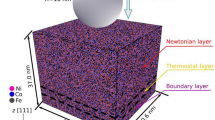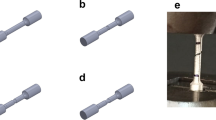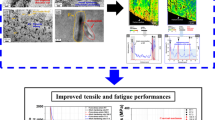Abstract
The elastic modulus of the cast superalloy IN738LC in various heat-treated conditions was determined with multiple specimens for each microstructure using the impulse excitation technique and the resonant frequencies while heating and cooling. Whereas the second and higher order harmonics were also excited in the high temperature range 700–1000 °C in 50 mm long specimens during controlled heating, analogous specimens 35 mm in length, impacted in similar fashion, did not excite the higher harmonics. Also, the 50 mm long specimens became excited and stayed in the second harmonic over broader temperature ranges during uncontrolled cooling inside the closed furnace. All precipitated conditions had nearly similar elastic data, varying from about 200 to 115 GPa, with small deviations, within 5%, found among multiple specimens of similar microstructures tested. Specimens with fine nano-size precipitates had a distinctly smaller rate of decrease in elastic modulus with increasing temperature, in contrast to a somewhat larger and nearly similar rate of decrease in specimens with coarse or medium-sized precipitates. This behavior is indicative of a larger average cohesive strength between the atoms and/or between the matrix and the precipitate particles in the former microstructure. The duplex size precipitate microstructure seemed to have both small and large drops in different specimens.
Similar content being viewed by others
References
E. Balikci, “Microstructure Evolution and Its Influence on Thermal Expansion and Tensile Properties of the Superalloy IN738LC at High Temperatures,” Ph.D. Dissertation, Louisiana State University, Baton Rouge, LA 1998
U. Bayerlein and H.G. Sockel, Determination of Single Crystal Elastic Constants from DS- and DR-Ni-Based Superalloys by a New Regression Method Between 20 °C and 1200 °C, Superalloys 1992, S.D. Antolovich, Ed., TMS, 1992, p 695–704
E. Balikci, A. Raman, and R.A. Mirshams, Influence of Various Heat Treatments on the Microstructure of Polycrystalline IN738LC, Metall. Mater. Trans. A, Vol 28 (No. 10), 1997, p 1993–2003
E. Balikci, R.A. Mirshams, and A. Raman, Microstructure Evolution in IN738LC in the Range 1120–1250 °C, Z. Metallkd, Vol 90 (No. 2), 1999, p 132–140
K. Heritage, C. Frisby, and A. Wolfenden, Impulse Excitation Technique for Dynamic Flexural Measurements at Moderate Temperature, Rev. Sci. Instrum., Vol. 59 (No. 6), 1988, p 973–974
S. Spinner and W.E. Tefft, A Method for Determining Mechanical Resonance Frequencies and Calculating Elastic Moduli from These Frequencies, Proc. ASTM, Vol 61, 1961, p 1221–1238
Prof. Yitshak Ram, Mechanical Engineering, LSU, Baton Rouge, LA (private communication)
E. Balikci, A. Raman and R.A. Mirshams, Microstructure Effect on the Thermal Expansion of Polycrystalline Superalloy IN738LC, Metall. Mater. Trans. A, Vol 30 (No. 11), 1999, p 2803–2808
Author information
Authors and Affiliations
Rights and permissions
About this article
Cite this article
Raman, A., Ibekwe, S. & Gabb, T. Impulse excitation study of elasticity of different precipitated microstructures in IN738LC at high temperatures. J. of Materi Eng and Perform 14, 188–193 (2005). https://doi.org/10.1361/10599490523337
Received:
Revised:
Issue Date:
DOI: https://doi.org/10.1361/10599490523337




